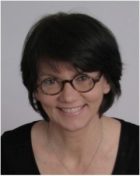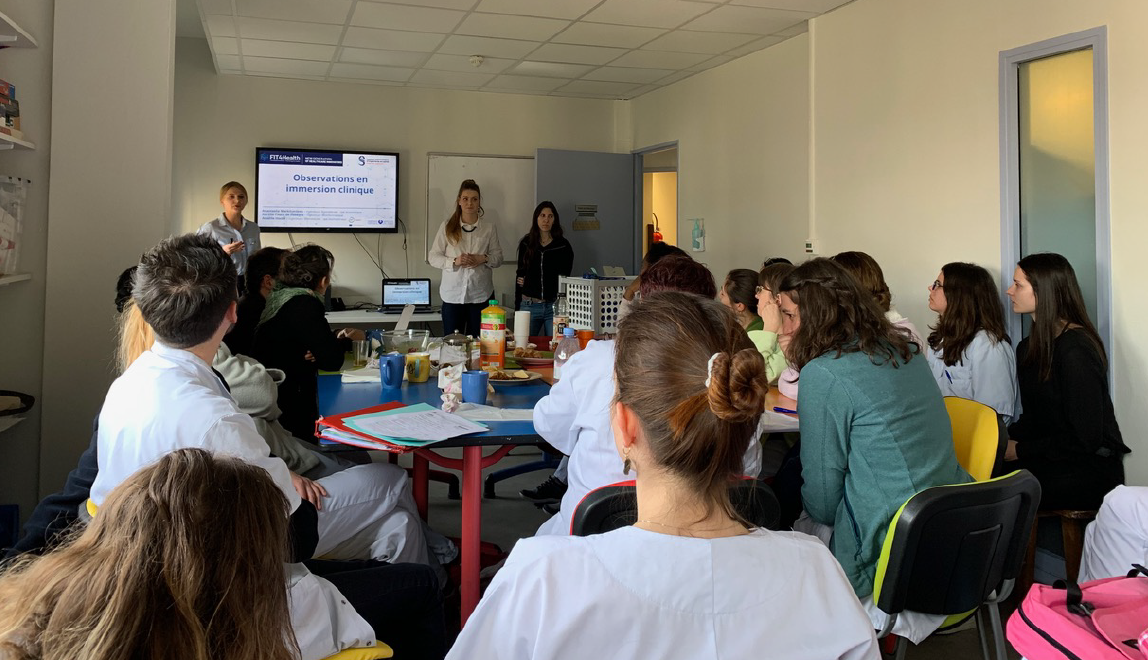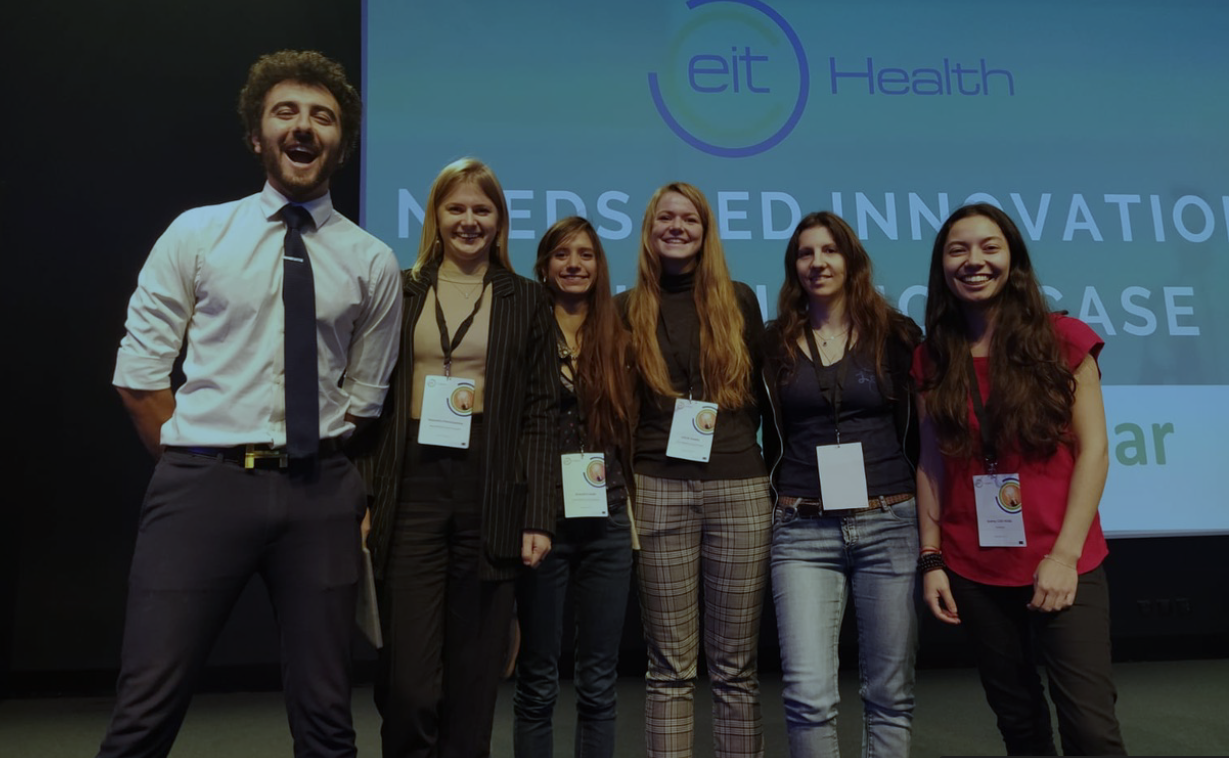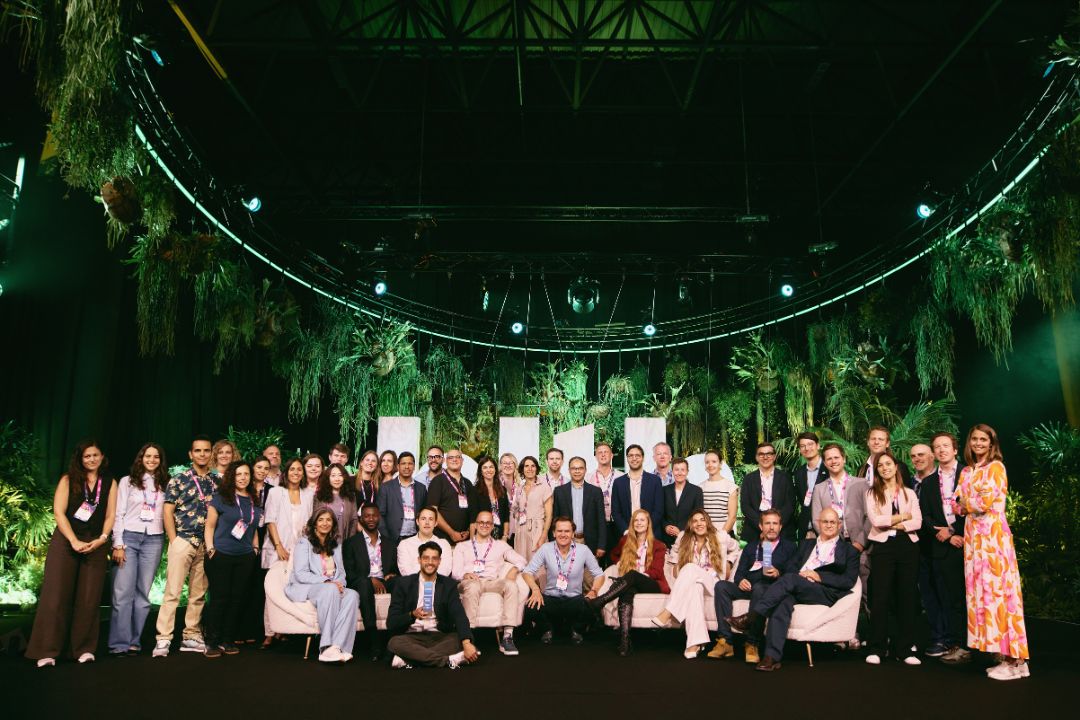24th June 2020
Deux équipes pluridisciplinaires de « fellows » ont suivi pendant 9 mois, d’octobre 2019 à juin 2020, le programme entrepreneurial d’immersion hospitalière, soutenu par EIT Health et lancé pour la première fois à Paris dirigé par Sorbonne Université. Ce parcours d’innovation se concentre sur des besoins réels insuffisamment satisfaits pour construire des solutions réelles. L’innovation fondée sur les besoins a plus de chances d’atteindre la maturité commerciale et, en fin de compte, d’aider les patients.

Le Docteur Christine Boutet-Rixe, Directrice exécutive de l’IUIS Sorbonne Université, et Djamel Bouhadjer, Program Manager, livrent dans une interview croisée les tenants et les aboutissants de ce programme ambitieux. Ils racontent, étape par étape, comment s’est organisé le parcours des 6 « fellows » sélectionnés pour FIT4Health.

Questions posées au Dr Christine Boutet-Rixe, Directrice exécutive de l’IUIS Sorbonne Université :
1.Pourquoi l’IUIS de Sorbonne Université a choisi de développer ce programme à Paris ?
“A travers l’IUIS (Institut Universitaire d’Ingénierie en Santé) Sorbonne Université (SU) est investie depuis plusieurs années dans les programmes Campus d’EIT Health. La découverte du programme Innovation Fellowship en 2018 nous a encouragés à implanter cette méthodologie d’innovation en France et plus particulièrement dans le contexte très riche de Sorbonne Université et de l’AP-HP (Assistance Publique- Hôpitaux de Paris ). L’innovation technologique en santé se doit de répondre à des besoins cliniques exprimés et nous souhaitons créer une dynamique entre soignants , patients, aidants et ingénieurs. Il est apparu naturel qu’un tel programme soit «incubé» à l’IUIS-SU et mis en place dans les services cliniques hospitaliers de APHP.SU, tout particulièrement à l’Hôpital de la Pitié-Salpêtrière à Paris. L’opportunité offerte par l’expertise du réseau international EIT Health Innovation fellowship de nous accompagner dans le développement et l’implantation du programme à Paris, a été un facteur de motivation. Ce « mentoring » collaboratif s’est matérialisé en amont mais aussi pendant tout le programme. Merci tout particulièrement aux collègues de University of Oxford, RiSe Stockolm, Biocat Barcelona, KTH et NUI Galway, qui ont grandement facilité cette première année de Fit4health à Paris !”
2. Pourquoi le choix de l’hôpital de la Pitié Salpetrière – Charles Foix ? Comment est organisé l’accueil dans les centres hospitaliers, quels services, quelles personnes impliquées ?
Le Pr Thomas Similowski, pneumologue et le Pr Jacques BODDAERT, gériatre, tous deux très impliqués dans la recherche en ingénierie en faveur de leur patients mais aussi des équipes soignantes de leur service respectif, se sont instantanément impliqués. Le Pr Jésus GONZALEZ, les Dr Valérie ATTALI et Judith COHEN-BITTAN ont pris les « fellows » sous leur aile et leur ont permis une immersion idéale dans les services hospitaliers concernés. Ce sont des convaincus de l’enjeu porté par FIT4Health “Need Pull” versus « Technology push »
Questions posées à Djamel Bouhadjer, Program Manager
1.Si vous deviez présenter Innovation Fellowship Program en Europe en une phrase ?
“Il s’agit d’un programme entrepreneurial d’immersion hospitalière d’ingénieurs pluridisciplinaires mais aussi de médecins dans le but de développer des solutions technologiques au plus près des besoins cliniques et des usages.”

2. Expliquez- nous les objectifs du programme FIT4Health et quels sont les partenaires impliqués ?
“Fit4Health vise à répondre aux besoins médicaux et cliniques par la technologie ( d’où le T de Technology). C’est un programme MedTech/e-Santé. En 9 mois, les défis sont pris d’observer la vie d’un service hospitalier, de rencontrer des patients, des soignants, des personnels impliqués dans le soins. La méthodologie Need-Led innovation développée au sein du réseau EIT Health et inspirée par le Stanford BioDesign permet de systématiser l’approche avec un rythme imposé en trois étapes : « Identify; Invent; Implement ». La phase d’identification est l’étape clés du programme . Elle permet à la fois aux fellows d’avoir une vision holistique de l’environnement médical, mais aussi de cartographier l’ensemble des besoins cliniques non adressés (unmet needs). C’est un premier livrable pour les membres des équipes médicales, que cette analyse détaillées des besoins qu’ils ou que leurs patients expriment. Sur la base de cette identification, 3 besoins forts sont sélectionnés, sur la base de 8 critères objectifs qui vont du potentiel marché à la faisabilité technique, en passant par l’analyse concurrentielle et la population ciblée. La sélection d’un besoin à adresser par une solution technologique est collégiale et pluridisciplinaire.”
3. Combien d’étudiants impliqués, d’où viennent-t-ils ? Comment avez-vous constitué les équipes?

“Nous avons constitués 2 équipes pluridisciplinaires de 3 fellows. Il sont soit ingénieurs dans le biomédical, l’informatique ou la biologie, soit médecins étudiants, soit ingénieurs en business développement. Nous souhaitons aussi attirer des designers, des pharmaciens, des Attachées de Recherche Clinique…. La priorité, c’est l’esprit d’équipe, la créativité et le goût de l’innovation au service de la médecine. Elément important : les fellows ne se connaissent pas avant le début du programme. Fit4Health, c’est donc aussi une expérience de teambuilding intense.”
4. Décrivez – nous les temps forts de ces 9 mois passés ?
“Le bootcamp introductif a été très riche. Nous l’avons voulu assez long (11 jours). A l’aide d’une coach/psychologue, nous avons développé la dynamique d’équipe. Avec des programmes managers européens et d’anciens fellows des programmes d’Oxford et de Stockolm, les fellows ont appris le méthodologie Need-Led Innovation et bénéficié de retours d’expériences enrichissants. Enfin, une patiente-experte a organisé une journée sur l’approche patient. C’est l’un des moments les plus forts de ces premiers mois de Fit4Health. Une étape importante a été l’intégration des équipes de fellows aux services hospitaliers. Les fellows ont su s’intégrer dans des départements hospitaliers sans en perturber le fonctionnement, mais tout en apportant une valeur ajoutée bien ressentie par les soignants.
Enfin, la période de confinement liée à la Crise Covid-19 aurait pu mettre le programme en péril compte tenu de l’éloignement des fellows du terrain hospitalier. Mais grâce à leur créativité et leur pugnacité, les fellows ont poursuivi le développement de leurs solutions technologiques tout en maintenant un lien à distance avec le terrain. Bravo à eux pour cela !”
5. Et aujourd’hui où en sont les projets et quelles sont les étapes futures ?
“A ce jour, 2 projets d’innovation ont émergé. Ces deux projets sont en phase de prototyping et de création de startups. Fit4health est le début d’une aventure entrepreneuriale. Des échanges sont déjà établis avec la cellule de transfert technologique de Sorbonne Université. Les fellows comptent bien poursuivre leurs projets, notamment en accédant aux Bootcamp de l’accélérateur EIT Health pour lesquels ils candidatent actuellement. Les équipes médicales, en particulier les professeurs (clinical mentors) sont dans cette dynamique et vont accompagner la phase d’implémentation des solutions dans leurs services respectifs.”
6. Envisagez- vous une autre session en 2021?
“FIT4Health va poursuivre son développement en 2021, avec un nouveau challenge : l’accès aux soins. 2 focus areas ont été identifiées: la santé maternelle et néonatale d’une part et les urgences hospitalières d’autre part. De nouveaux partenaires se joignent au mouvement : l’AP-HP, des professeurs experts dans les domaines visés et la Fondation Sanofi Espoir.”
FIT4Health: Innovation Fellowship Program, 1st time in Paris
Two multidisciplinary teams of “fellows” followed the entrepreneurial hospital immersion programme for 9 months, from October 2019 to June 2020, supported by EIT Health and launched for the first time in Paris, led by Sorbonne University. This innovation path focuses on real needs that if unmet prevent to build real solutions. Needs-based innovation is more likely to reach commercial maturity and ultimately help patients.
Dr Christine Boutet-Rixe, Executive Director of the IUIS Sorbonne University and Djamel Bouhadjer, Program Manager give in a cross interview the ins and outs of this ambitious program. They tell, step by step, how the 6 fellows selected for FIT4Health have organized their journey.

Dr Christine Boutet-Rixe, Executive Director of IUIS Sorbonne University answered to some of our questions:
1.Why did the IUIS of Sorbonne University choose to develop this program in Paris?
“Through the IUIS (Institut Universitaire d’Ingénierie en Santé) Sorbonne University (SU) has been involved for several years in EIT Health’s Campus programmes. The discovery of the Innovation Fellowship program in 2018 encouraged us to implement this innovation methodology in France, particularly in the very rich context of Sorbonne University and the AP-HP (Assistance Publique-Hôpitaux de Paris). Technological innovation in healthcare must respond to expressed clinical needs and we wish to create a dynamic between carers, patients, caregivers and engineers. It seemed natural that such a programme should be “incubated” at IUIS-SU and implemented in the clinical hospital departments of APHP.SU, particularly at the Pitié-Salpêtrière Hospital in Paris. The opportunity offered by the expertise of the international EIT Health Innovation fellowship network to accompany us in the development and implementation of the programme in Paris was a motivating factor. This collaborative “mentoring” took place upstream but also throughout the programme. Special thanks to colleagues from University of Oxford, RiSe Stockolm, Biocat Barcelona, KTH and NUI Galway, who greatly facilitated this first year of Fit4health in Paris!”
2.Why the choice of the Pitié Salpetrière – Charles Foix Hospital? How is the reception in the hospital centres organised, what services, what people are involved?
“Pr. Thomas Similowski, respirologist and Pr. Jacques BODDAERT, geriatrician, both very involved in engineering research for the benefit of their patients but also the care teams of their respective departments, were instantly involved. Pr Jesus GONZALEZ, Dr Valérie ATTALI and Judith COHEN-BITTAN took the fellows under their wings and gave them an ideal immersion in the hospital departments concerned. They fully support the challenge addressed by FIT4Health “Need Pull” versus “Technology Push.”
Djamel Bouhadjer, Program Manager answered to our questions:
1.If you had to present the Innovation Fellowship Program in Europe in one sentence?

“This is an entrepreneurial hospital immersion program for multidisciplinary engineers and doctors with the aim of developing technological solutions that are as close as possible to clinical needs and uses.“
2. Explain the objectives of the FIT4Health program and which partners are involved?
“Fit4Health aims to address medical and clinical needs through technology (hence the T of Technology). It is a MedTech/e-Health program. In 9 months, the challenges are taken to observe the life of a hospital department, to meet patients, caregivers, staff involved in care. The Need-Led innovation methodology developed within the EIT Health network and inspired by the Stanford BioDesign allows to systematize the approach with an imposed rhythm in three steps: “Identify; Invent; Implement”. The identification phase is the key stage of the programme. It allows the fellows to have a holistic vision of the medical environment, but also to map all unmet clinical needs. It is a first deliverable for medical team members, whether it is a detailed analysis of the needs they or their patients express. On the basis of this identification, 3 strong needs are selected, based on 8 objective criteria ranging from market potential to technical feasibility, through competitive analysis and target population. The selection of a need to be addressed by a technological solution is collegial and multidisciplinary.”
3.How many students are involved, where do they come from? How did you build the teams?

“We formed 2 multidisciplinary teams of 3 fellows. They are either engineers in biomedical, computer science or biology, or student doctors, or business development engineers. We also want to attract designers, pharmacists, Clinical Research Associates…. The priority is team spirit, creativity and a taste for innovation in the service of medicine. Important element: Fellows do not know each other before the start of the program. Fit4Health is therefore also an intense team-building experience.”
4.Could you describe the highlights of the past 9 months?
“The introductory bootcamp was very rich. We wanted it to be quite long (11 days). With the help of a coach/psychologist, we developed team dynamics. With European managers programs and former fellows from Oxford and Stockolm programs, the fellows learned the Need-Led Innovation methodology and benefited from enriching feedback. Finally, a patient-expert organised a day on the patient approach. This was one of the highlights of the first months of Fit4Health.
An important step was the integration of the teams of fellows into the hospital services. The fellows were able to integrate themselves into hospital departments without disrupting their functioning, but with an added value well felt by the carers. Finally, we were afraid that the lockdown linked to the Covid-19 crisis could have jeopardized the programme given the distance of the fellows from the hospital grounds. But thanks to their creativity and pugnacity, the Fellows continued to develop their technological solutions while maintaining a remote link with the field. Congratulations to them for that!”
5. And where are the projects today and what are the future steps?
“To date, 2 innovation projects have emerged. These two projects are in the prototyping and startup creation phase. Fit4health is the beginning of an entrepreneurial adventure. Exchanges are already established with the technology transfer unit of Sorbonne University. The fellows intend to pursue their projects, in particular by accessing the EIT Health accelerator Bootcamps for which they are currently applying. The medical teams, particularly the professors (clinical mentors) are in this dynamic and will accompany the implementation phase of the solutions in their respective departments.”
6. Are you planning another session in 2021?
“FIT4Health will continue its development in 2021, with a new challenge: access to care. 2 focus areas have been identified: maternal and neonatal health on the one hand and hospital emergencies on the other. New partners are joining the movement: AP-HP, professors with expertise in the targeted areas and the Sanofi Espoir Foundation.”
New data shows AI innovation needs skills beyond coding

The largest live dataset of AI start-up talent analysed.
Europe's top health start-ups take centre stage: EIT Health Catapult winners are revealed at HLTH Europe

2025 Catapult programme winners announced.
Finding Europe’s next healthtech leaders: Insights from Antoine D’Hollander

Insights from Antoine D’Hollander, Capricorn Partners.